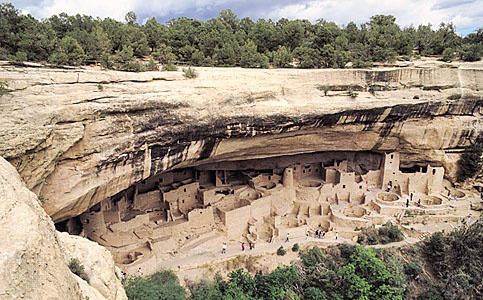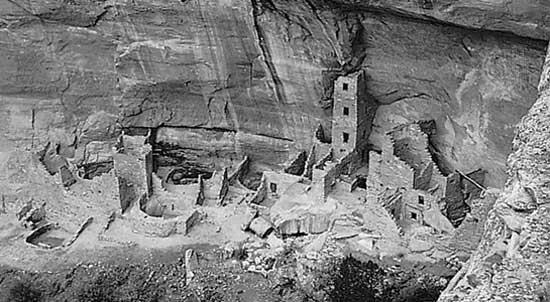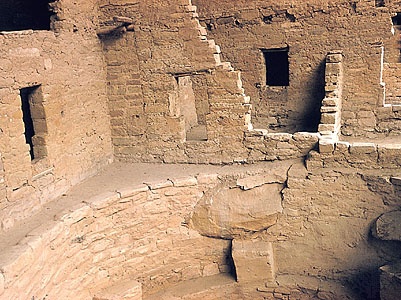Mesa Verde National Park
park, Colorado, United States


national park in southwestern Colorado, U.S., established in 1906 to preserve notable prehistoric cliff dwellings (cliff dwelling); it was designated a World Heritage site in 1978. Occupying a high tableland area of 81 square miles (210 square km), it contains hundreds of pueblo (Indian village) ruins up to 13 centuries old. The most striking are multistoried apartments built under overhanging cliffs. Besides the ruins, the park has some spectacular and rugged scenery.
The park occupies part of a large sandstone plateau rising more than 8,500 feet (2,600 metres) above sea level that slopes gently to the south. Stream erosion during the past two million years cut deep canyons into the plateau, leaving narrow strips of high tableland, or mesa, between the canyons. Water erosion formed niches and alcoves of various sizes in the sandstone of these canyon walls (where the cliff dwellings are located). On the top of these mesas there are windblown deposits of fertile reddish soil (loess). The climate is semiarid and, according to the examination of tree rings, has changed little during the past 600 years. The area's plant life is adapted to the semiarid climate: piñon-juniper forest is the dominant vegetation on the mesas, and sagebrush is the characteristic vegetation on the canyon floors. Elk are the most common large animals, and there are a few bears and mountain lions and many smaller mammals in the park. Snakes and lizards also abound, as do birds.
About 550 CE, Basketmaker peoples, direct ancestors of the region's later Ancestral Pueblo (Ancestral Pueblo culture) (Anasazi) peoples, moved into the Mesa Verde area. They made pottery and built clusters of semi-subterranean pit houses on the mesa tops at an elevation of 7,000 feet (2,000 metres), where they also cultivated corn (maize), beans, and squash. There was usually sufficient rainfall for their crops, and springs and seeps provided drinking water. About 750 CE, surface dwellings began to be constructed, consisting of houses with vertical walls and flat roofs, all joined together in long rows; archaeologists designate this as the Pueblo I period. Sandstone began to be more commonly used in house construction, and one or more subterranean pit rooms (kivas), probably used for ceremonial purposes, were dug in front of these row houses. Houses with more than one story and round towers also began to be built.

 Between 1150 and 1200 the Ancestral Pueblo peoples shifted their dwelling sites from the mesa tops into the alcoves in the canyon walls, where they began to build the cliff houses, with rooms averaging 6 by 8 feet (1.8 by 2.4 metres) in size, using sandstone and the construction methods developed earlier. Crops continued to be cultivated on the mesa tops; dry-farming techniques were used. The alcoves under the canyon rims that face south-southwest were preferred for cliff dwellings, probably because of the warming effect of winter sunshine. The largest cliff dwelling in the park is Cliff Palace, which housed as many as 250 people in its 217 rooms and 23 kivas. Long House, the second largest cliff dwelling, has 150 rooms and 21 kivas, where some 150 people lived. However, of the approximately 600 cliff dwellings in the park, most have only one to five rooms each. The population of Mesa Verde probably peaked at about 5,000 persons.
Between 1150 and 1200 the Ancestral Pueblo peoples shifted their dwelling sites from the mesa tops into the alcoves in the canyon walls, where they began to build the cliff houses, with rooms averaging 6 by 8 feet (1.8 by 2.4 metres) in size, using sandstone and the construction methods developed earlier. Crops continued to be cultivated on the mesa tops; dry-farming techniques were used. The alcoves under the canyon rims that face south-southwest were preferred for cliff dwellings, probably because of the warming effect of winter sunshine. The largest cliff dwelling in the park is Cliff Palace, which housed as many as 250 people in its 217 rooms and 23 kivas. Long House, the second largest cliff dwelling, has 150 rooms and 21 kivas, where some 150 people lived. However, of the approximately 600 cliff dwellings in the park, most have only one to five rooms each. The population of Mesa Verde probably peaked at about 5,000 persons.By 1300, following the Great Drought (1276–99), most of the people had left Mesa Verde, moving south, according to archaeological evidence, into what is now New Mexico and Arizona. These people are among the ancestors of the present-day Pueblo Indians.
Several of the cliff dwellings, including Cliff Palace, are open to visitors; camping is available, and a lodge is open in the park in the summer.
- romance stanza
- Romanche Gap
- Roman Curia
- Roman de Fauvel
- Roman de la rose
- Roman Dmowski
- Roman-Dutch law
- romanechite
- Roman emperors
- Roman Empire
- Roman Empire, Eastern
- Romanesque art
- roman-fleuve
- Roman Forum
- Romania
- Romania, flag of
- Romanian language
- Romanian literature
- Romanian Orthodox Church
- Romanino, Il
- Roman Jakobson
- Roman-Kosh, Mount
- Roman law
- Roman numeral
- Romano, Luis